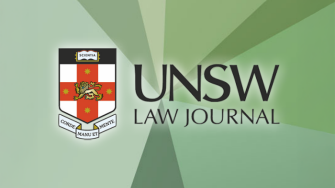Call for Submissions to the University of New South Wales Law Journal Issue 48(2)
‘Dynamics of Power within Criminal Law’
‘Dynamics of Power within Criminal Law’

The UNSW Law Journal (‘Journal’) is currently welcoming submissions for the thematic component of Issue 48(2). The topic for this thematic is ‘Dynamics of Power within Criminal Law’.
Dynamics of power is an inherently broad concept to define, but generally refers to the underlying influence that individuals, groups or ideas hold within a particular context. They have a dominant role in many aspects of criminal law, whether it be in the relationships and interactions between different criminal justice stakeholders, or between the conflicting public opinion and justice considerations that affect suggested reforms. In recent years there has been an increasing discussion around dynamics of power, particularly surrounding the barriers they can present to complainants. For example, the increase in reported domestic and gender-based violence in 2023 and 2024 raises questions as to the power dynamics that have led to these increases, and how they may prevent victims from seeking support. Further, the inherent power dynamics present between children and the legal system presents various barriers to children’s access to this system as defendants or complainants.
Recent developments within other areas of criminal law highlight existing and emerging dynamics of power between various stakeholders. For example, developments in the common law and statute affecting the sentencing of Aboriginal and Torres Strait Islander defendants highlights an interesting power dynamic between Aboriginal and Torres Strait Islander peoples and judicial officers. Furthermore, the recent enactment of affirmative consent laws for sexual assault offences in New South Wales (‘NSW’) highlights key issues about the balance between social and political pressure for reform, and legal considerations of what is considered fair and just. Additionally, the speed and frequency of media coverage surrounding criminal proceedings, as facilitated by social media, raises interesting debates around the dynamics between open justice and the right to a fair trial. Finally, the relationship between minority groups and police and the impact that the inherent power dynamics within this relationship can have on the broader criminal justice system.
In a world in which power dynamics are increasingly at play in political and social realms, their effect in our criminal justice system should be analysed. Additionally, current and emerging measures that could have positive or negative effects in limiting such dynamics should be considered.
In writing submissions, authors may wish to explore the following issues.
Domestic Violence
Sexual Assault Law Reforms
The Media’s Role in Criminal Trials
Children and the Law
Indigenous Australians under Criminal Law
Police Powers
However, authors are not limited to these topics and are encouraged to draw upon their own interests and expertise. The Journal welcomes comparative, inter-disciplinary, historical and novel methodological approaches, as well as doctrinal scholarship.
The submission deadline for the thematic Issue 48(2) is 15 November 2024, with publication set for late July 2025. Any changes to these deadlines will be updated on the Journal’s website.
Submissions should be between 7,000 and 13,000 words in length, excluding footnotes. The style guide for the Journal is the fourth edition of the Australian Guide to Legal Citation, as supplemented by the latest edition of the Journal’s ‘Additions’, which is available on our website.
The Journal is an independent, peer-reviewed publication. While publication is subject to peer review, publication decisions remain at the Editor’s discretion, in consultation with the Executive Committee of the Journal. The Journal does not publish articles that have been, or will be, published elsewhere, either in identical or substantially similar form. Please contact the Journal at law.journal@unsw.edu.au if you are interested or have queries about submitting for Issue 48(2).
If you intend to submit an article, it would be greatly appreciated if you could please provide some early indication of your proposed topic or area of research. We strongly encourage you to pass this call for submissions to any colleagues, research networks or organisations who may be interested in making a submission.
Yours sincerely,
Cordella O’Loughlin
Editor, Issue 48(2)
UNSW Law Journal
news & updates